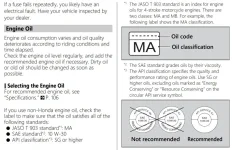Enlighten me please, if you know the answer, as this question has been bugging me since the day of purchase... Vehicle in question is 2020 Honda Ruckus.
Why does Honda specifically state in the owner's manual NOT to use "Resource Conserving" motor oil? It would make sense if the engine was air-cooled, but this 49CC ("GET" is Honda's engine series designation for it) is liquid-cooled and does not have a shared sump, so shouldn't be extremely hard on oil. Anything I'm overlooking?


Yes it is a small 49CC engine, but being liquid-cooled and with frequent OCIs I don't exactly see how the "Resource Conserving" category would make a difference. Honda recommends 2500-mile OCI with the 0.6qt (~20oz) capacity. I do 500-700 mile OCIs though. Just because it has no oil filter (just a mesh screen), I'm a heavier rider than average, and CVT keeps this tiny "GET" engine at 7000-9000 RPM most of the time. (At >10k RPM these usually start floating the valves, and valve to piston interference happens.) What exactly about "Resource Conserving" scares Honda enough to include the cautionary statements in the owner's manual against it? School me please, legitimately just trying to learn here. This engine seems to be as close to a "normal" car engine as it gets, compared to its air-cooled rivals. Yet I haven't seen many cars caution against "Resource Conserving" oils, quite the opposite actually.
EDIT:
Also found this:
The former supplemental category, which was called Energy Conserving required only fuel saving properties from the oil. Resource Conserving requires further properties like:
- Emission system protection
- Turbocharger protection
- Compatibility with engines operating on ethanol containing fuels, up to E-85.
And my engine has none of these things... Unless E-10 fuel counts. I do however try to only fill up with Ethanol-Free fuel. But occasional tank of E-10 does happen, depending on ethanol-free fuel availability.
Why does Honda specifically state in the owner's manual NOT to use "Resource Conserving" motor oil? It would make sense if the engine was air-cooled, but this 49CC ("GET" is Honda's engine series designation for it) is liquid-cooled and does not have a shared sump, so shouldn't be extremely hard on oil. Anything I'm overlooking?


Yes it is a small 49CC engine, but being liquid-cooled and with frequent OCIs I don't exactly see how the "Resource Conserving" category would make a difference. Honda recommends 2500-mile OCI with the 0.6qt (~20oz) capacity. I do 500-700 mile OCIs though. Just because it has no oil filter (just a mesh screen), I'm a heavier rider than average, and CVT keeps this tiny "GET" engine at 7000-9000 RPM most of the time. (At >10k RPM these usually start floating the valves, and valve to piston interference happens.) What exactly about "Resource Conserving" scares Honda enough to include the cautionary statements in the owner's manual against it? School me please, legitimately just trying to learn here. This engine seems to be as close to a "normal" car engine as it gets, compared to its air-cooled rivals. Yet I haven't seen many cars caution against "Resource Conserving" oils, quite the opposite actually.
EDIT:
Also found this:
The former supplemental category, which was called Energy Conserving required only fuel saving properties from the oil. Resource Conserving requires further properties like:
- Emission system protection
- Turbocharger protection
- Compatibility with engines operating on ethanol containing fuels, up to E-85.
And my engine has none of these things... Unless E-10 fuel counts. I do however try to only fill up with Ethanol-Free fuel. But occasional tank of E-10 does happen, depending on ethanol-free fuel availability.
Last edited:
